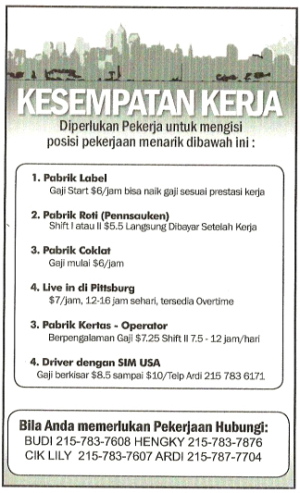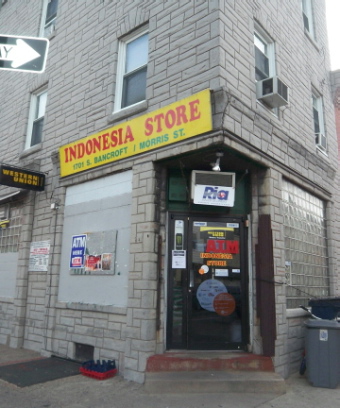Undocumented Indonesian migrant labourers - known locally as kuli dollar - work long hours in difficult conditions in search of prosperity in Philadelphia
Dahlia Gratia Setiyawan
|
|
A white van turns onto Mifflin Street. With the engine still running the driver sounds the horn three times, breaking the silence of the 4am darkness. In the middle of the block, a door opens and two people emerge. Quickly greeting the others in the vehicle, they slide into their seats as the van heads off to pick up its next group of passengers. Another day labouring in the warehouses, plants and factories of the region has begun for Indonesian migrant workers in Philadelphia.
Beginning in the late 1990s, Indonesians leaving economic and social instabilities in their homeland settled in the once predominantly European immigrant and African American working-class neighbourhoods of 'South Philly'. The area became home to more than 5000 Indonesian migrants, most of them ethnic Chinese. Many of the early arrivals originated from Surabaya. The majority have at least a high school degree and, in many cases, also businesses and property or other assets in Indonesia. Whilst a number have pursued asylum cases based on claims of ethnic or religious persecution, almost all - including many of those who later claimed asylum - entered on tourist visas with the primary intention of working.
These Indonesian migrants were drawn to Philadelphia by the promise of plentiful employment, hoping to turn their tourist visas into tickets to under-the-table jobs. So was born the self-named 'kuli dollar', the Indonesian migrant worker labouring under coolie-like conditions for a chance at earning the coveted currency of Uncle Sam.
Hard labour
The first large-scale waves of migrants entered Philadelphia with the help of connections in the US. Some of them used agencies in Indonesia, a trend that increased significantly from around 2000-2002. For more than a decade now these agents have found migrants jobs stuffing envelopes in junk mailing companies or unloading goods from warehouse docks as well as cleaning, gutting and disposing of carcasses at poultry processing plants. Indonesian migrants looking for work also find a variety of positions available to them in other industries including laundries, produce stores and hospitality.
For a fee starting at Rp40 million (AU$5000), many of these agencies continue to assist the smaller number of prospective labourers migrating at present to obtain all the documents they need. A document vendor might also prepare poorly-credentialed applicants for their consular interviews by selling them fraudulent papers. Until immigration controls were tightened after 9/11, an assumed name and background story to match could be purchased as well. For an additional fee, a local partner takes over once the migrant arrives in the US, arranging airport pickups, housing and - most importantly - work.
Agents are more than happy to provide assurances about the availability of employment to migrants eager to settle their debts and begin sending remittances. But they are much less candid about the squalor in which the newcomers might have to live. For early migrants in particular, this only became apparent when they arrived to find themselves sharing rodent and roach infested rooms with other Indonesian workers in row-houses and walk-up apartment buildings in South Philly. Slumlords - many of whom own agencies - charge a monthly rent of hundreds of dollars for a place to stay along with a mattress and, if lucky, a sheet and pillow to go with it.
For many, the first shift at their agency-arranged job begins as early as the morning after they arrive. And the conditions they face there are just as challenging. Many migrants spend up to two hours commuting each way in the agency's vans and often put in double shifts of up to 16 hours with no overtime pay. Their hourly salaries are just on or below minimum wage rates - between US$5 and US$7 - from which agents deduct their fees. Because many Indonesian migrant labourers are illegal aliens, they labour under constant fear of being caught up in US Immigration and Customs Enforcement (ICE) raids. If injured on the job, they are ineligible for financial compensation or subsidised medical care - the sort of thing for which agents rarely foot the bill.
 |
|
A job ad in an Indonesian community newspaper / Dahlia Gratia Setiyawan |
Learning quickly on the job is imperative to holding one's spot on an agency crew especially since migrants have often had no prior training. Even the most skilled workers among them have no guarantee of job security. From working multiple day and night-time shifts, migrants can find themselves without any work at all. This can happen because agents don't get enough job orders or simply because the agency's van driver didn't turn up to work. Most commonly a factory or warehouse has no need for workers due to production downturns and the agency cannot find a replacement work site.
With rent, water, electricity, and phone bills still due and savings needed for food and remittances, a migrant faces near disaster should they become unemployed for more than a few weeks. When this happens, some turn to placements outside of the Philadelphia region, moving to smaller Pennsylvania towns such as York and Harrisburg or to the resort area known as The Poconos to look for work. Others find employment as restaurant dishwashers or kitchen hands.
These jobs are considered to be the worst of the lot. While they allow labourers to accrue savings more quickly, single shifts last over twelve hours, the physical demands can be harsher than factory labour and live-in requirements force them to reside where they work, albeit rent free. The fact that they only get one day off a week isolates them from connecting with fellow Indonesians who are able to gather on weekends to shop and sightsee downtown, take day trips to New York and Atlantic City or attend services at one of the many places of worship established by Indonesian religious leaders in Philly.
Living the dream
Despite overwhelming odds, many of those who arrived in the first wave or since have done well. Savvy migrants negotiate jobs and a rate of pay based on the skills and experience they have accrued. Some obtain vehicle-operating licenses and become agency van drivers. Those proficient in English become crew leaders, serving as valuable intermediaries between the workers, agencies and jobsites. Others bypass the agency system altogether and strike off on their own, able to earn a living in the community as caterers, hair stylists or handymen. Migrants who gain permanent residency via successful asylum claims or other means are able to leave their shifts in the factories and warehouses behind altogether. Some have established restaurants, cafés or corner stores that specifically cater to Indonesian migrants. A few have become agents. Others have moved out of the community entirely, finding white-collar occupations and homes away from South Philly. Every successful story of a migrant who has made it is a source of encouragement to those who remain in the US.
Still a strong presence in the city, over the past few years the Indonesian migrant community has nonetheless decreased in size. The initial surge of newcomers has since slowed and numerous individuals who overstayed their visas have been involuntarily deported. Many long-term migrants have also willingly returned to Indonesia. Yet for the approximately 2000 men and women who continue on as undocumented labourers in Philadelphia, the pursuit of the American dream and the challenges that go with it continues. Their hopes for the future of their community and for the continuation of their own lives in the US are now carried by their American-born children. And as the next generation begins to come of age, it seems certain that conditions for Indonesians living in Philly will continue to improve.
Dahlia Gratia Setiyawan (dsetiyawan@ucla.edu) is a PhD Candidate at the University of California, Los Angeles. She is writing her dissertation on state-level monitoring of Indonesians in Surabaya and Philadelphia.












